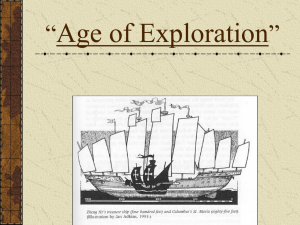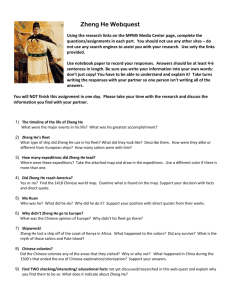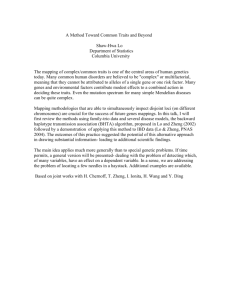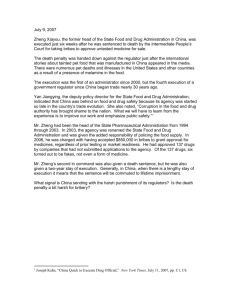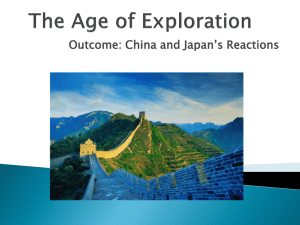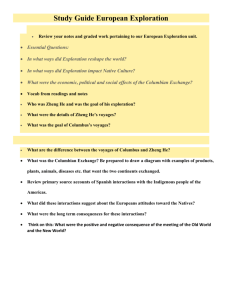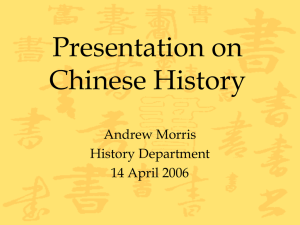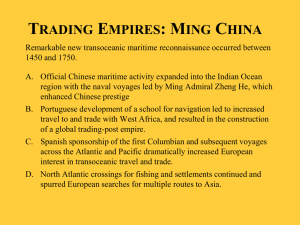Admiral Zheng He Voyages Across the Indian Ocean, 1405-1433
advertisement
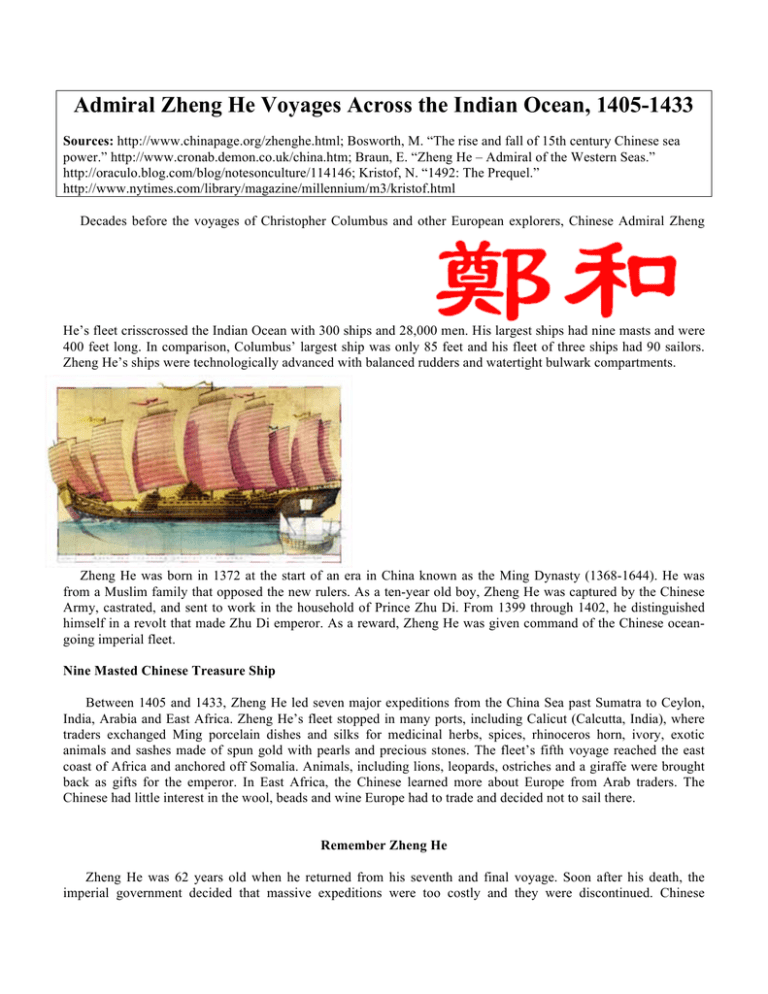
Admiral Zheng He Voyages Across the Indian Ocean, 1405-1433 Sources: http://www.chinapage.org/zhenghe.html; Bosworth, M. “The rise and fall of 15th century Chinese sea power.” http://www.cronab.demon.co.uk/china.htm; Braun, E. “Zheng He – Admiral of the Western Seas.” http://oraculo.blog.com/blog/notesonculture/114146; Kristof, N. “1492: The Prequel.” http://www.nytimes.com/library/magazine/millennium/m3/kristof.html Decades before the voyages of Christopher Columbus and other European explorers, Chinese Admiral Zheng He’s fleet crisscrossed the Indian Ocean with 300 ships and 28,000 men. His largest ships had nine masts and were 400 feet long. In comparison, Columbus’ largest ship was only 85 feet and his fleet of three ships had 90 sailors. Zheng He’s ships were technologically advanced with balanced rudders and watertight bulwark compartments. Zheng He was born in 1372 at the start of an era in China known as the Ming Dynasty (1368-1644). He was from a Muslim family that opposed the new rulers. As a ten-year old boy, Zheng He was captured by the Chinese Army, castrated, and sent to work in the household of Prince Zhu Di. From 1399 through 1402, he distinguished himself in a revolt that made Zhu Di emperor. As a reward, Zheng He was given command of the Chinese oceangoing imperial fleet. Nine Masted Chinese Treasure Ship Between 1405 and 1433, Zheng He led seven major expeditions from the China Sea past Sumatra to Ceylon, India, Arabia and East Africa. Zheng He’s fleet stopped in many ports, including Calicut (Calcutta, India), where traders exchanged Ming porcelain dishes and silks for medicinal herbs, spices, rhinoceros horn, ivory, exotic animals and sashes made of spun gold with pearls and precious stones. The fleet’s fifth voyage reached the east coast of Africa and anchored off Somalia. Animals, including lions, leopards, ostriches and a giraffe were brought back as gifts for the emperor. In East Africa, the Chinese learned more about Europe from Arab traders. The Chinese had little interest in the wool, beads and wine Europe had to trade and decided not to sail there. Remember Zheng He Zheng He was 62 years old when he returned from his seventh and final voyage. Soon after his death, the imperial government decided that massive expeditions were too costly and they were discontinued. Chinese imperial attention turned toward supporting internal trade and the logs that Zheng He kept during his voyages were destroyed. By 1474, the ocean-going fleet was reduced to one-third of its original size and the empire became increasingly isolated. A legal decree in 1500 made it a capital offense for a Chinese merchant to go to sea in a ship with more than two masts unless they had special permission. Another decree in 1525 authorized officials to destroy the larger ships. Only a stone pillar, discovered in the 1930s in China’s Fujian province, remains to testify to the achievements of the “Admiral of the Western Seas” and his fleet. Admiral Zheng He Voyages Across the Indian Ocean, 1405-1433 A. Text engraved on a stone tablet in 1432 commemorating the expeditions of Zheng He. Source: Duyvendak, J. (1938) “The True Dates of the Chinese Maritime Expeditions in the Early Fifteenth Century.” “The Imperial Ming dynasty in unifying seas and continents. . . even goes beyond the Han and the T’ang [dynasties]. The countries beyond the horizon and from the ends of the earth have all become subjects. . . Thus the barbarians from beyond the seas. . . have come to audience bearing precious objects. . . The emperor has ordered us. . . to make manifest the transforming power of the Imperial virtue and to treat distant people with kindness. . . We have seven times received the commission of ambassadors [and have visited] altogether more than thirty countries large and small. We have traversed immense water spaces and have beheld huge waves like mountains rising sky-high, and we have set eyes on barbarian regions far away hidden in a blue transparency of light vapors, while our sails loftily unfurled like clouds day and night continued their course, traversing those savage waves as if we were treading a public thoroughfare. . . Therefore we have recorded the years and months of the voyages. . . . We have anchored in this port awaiting a north wind to take the sea. . . and have thus recorded an inscription in stone. . . by the principal envoys, the Grand Eunuchs Cheng Ho [Zheng He] and Wang Ching-hung, and the assistant envoys.” 1. What did Zheng He accomplish on his voyages? 2. What “strange” things did he witness B. Map of Ming Dynasty China, 1368-1644. This map shows the route traveled by Zheng He (also known as Cheng-ho). 1. What cities did he visit on these voyages? 2. What modern-day countries did he visit?
